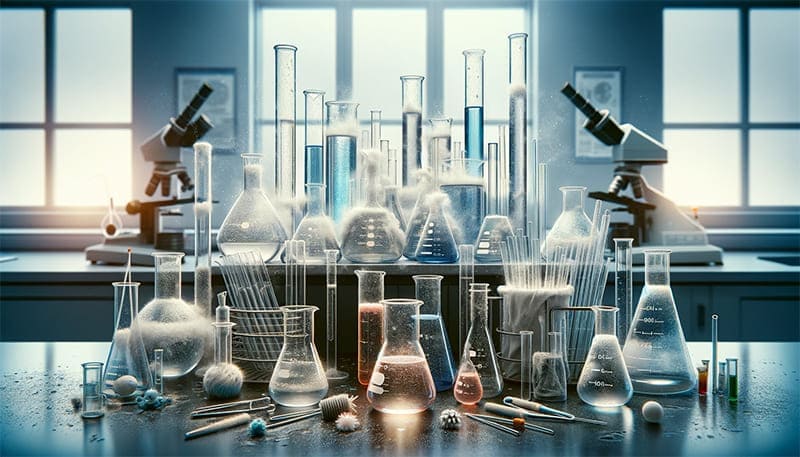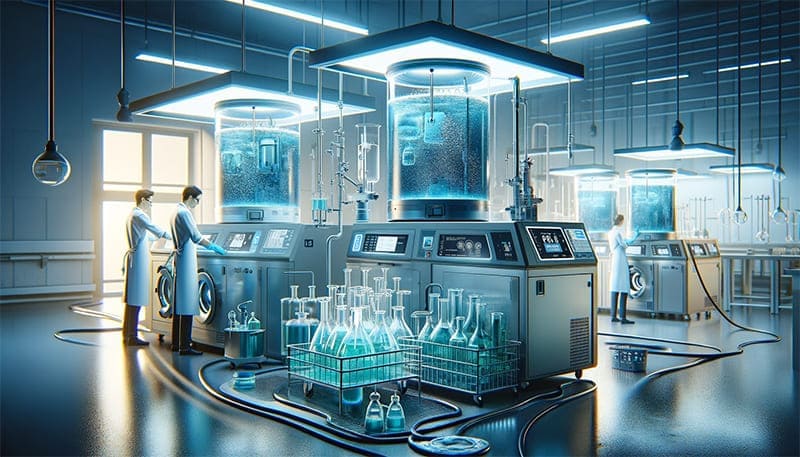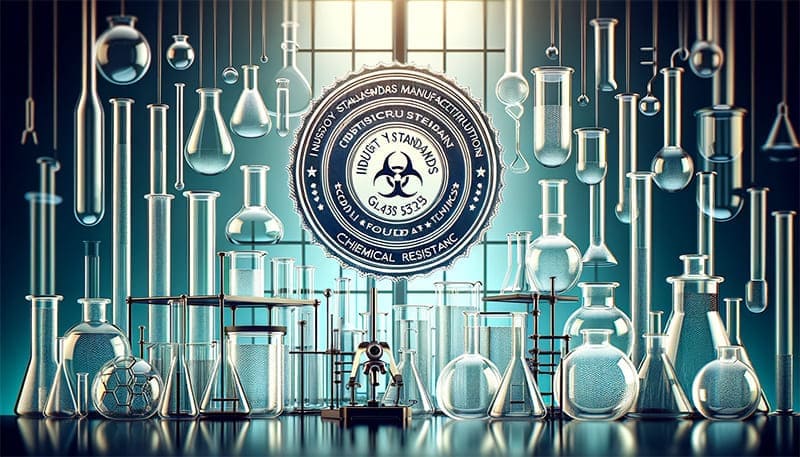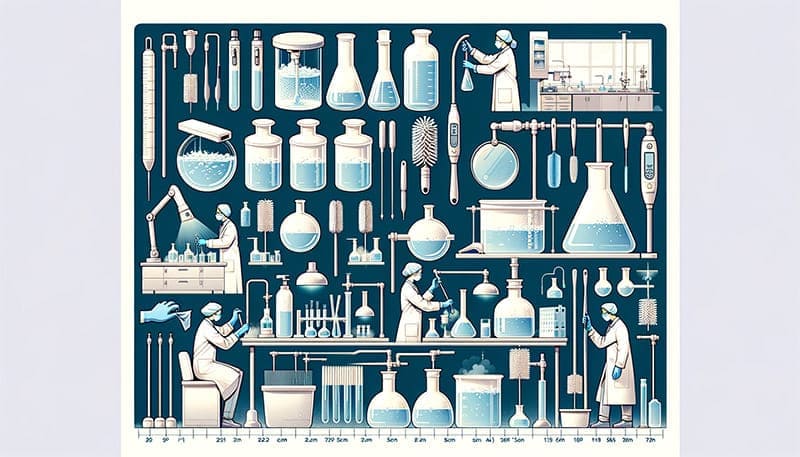In the world of scientific research, the cleanliness of laboratory glassware is more than a matter of tidiness—it’s a cornerstone of experimental accuracy and safety. But what does it take to ensure that every beaker and flask is not just visually clean but scientifically sterile? Let’s dive into the nuances of this crucial laboratory practice.
The meticulous process of cleaning laboratory glassware is a fusion of art and science. It’s a critical task that underpins the reliability and safety of experimental results.
Understanding and implementing effective glassware cleaning techniques are not just recommended practices; they’re essential for the integrity of scientific work.

Why Clean Glassware Matters in the Lab
Clean glassware is paramount in the lab for several reasons. It ensures that no residual substances interfere with experimental outcomes. This is crucial because even the smallest impurity can skew results, leading to inaccurate data and potentially dangerous conclusions.
Choosing the Right Cleaning Agent
The selection of cleaning agents is a science in itself. Different types of residues – organic, inorganic, oily, or protein-based – require specific detergents. For instance, alkaline detergents are effective against organic residues, while acidic solutions are best for inorganic deposits. It’s imperative to match the detergent to the type of residue for optimal cleaning without damaging the glassware.
Effective Cleaning Techniques
- Manual Cleaning: Simple yet effective for basic containers like test tubes and petri dishes. This involves scrubbing with a brush, detergent, and rinse.
- Ultrasonic Cleaning: For intricate items, ultrasonic cleaners use high-frequency sound waves to remove stubborn residues.
- Automated Washing: Ideal for high-volume or complex glassware, automated washers offer consistent and thorough cleaning.
Attention to Detail: The Key in Glassware Cleaning
- Correct Methodology: Choose the method based on the glassware’s design and contamination level.
- Detergent Diligence: The right concentration of detergent is crucial to avoid damage or residue.
- Temperature Control: Both the washing and rinsing water temperatures can significantly affect cleaning efficacy.
- Rinse Thoroughly: Residual detergents can be as problematic as the original contaminants.
- Proper Drying and Storage: Ensuring glassware is completely dry and stored in a dust-free environment is vital to maintain cleanliness.
Handling Tough Contaminants
- Protein Stains: Enzymatic detergents can break down these stubborn residues.
- Oily Residues: Surfactant-based detergents are effective for removing grease and oil.
- Inorganic Deposits: Acidic detergents are best for tackling calcium, magnesium, or other mineral deposits.
- Soot and Carbon: Solvents like alcohol can dissolve these difficult residues.

Advanced Cleaning Considerations
Beyond the basic procedures, there are additional factors that can elevate the effectiveness of glassware cleaning in laboratories.
- Handling Delicate Glassware: Some lab instruments are extremely fragile. Handling them with care during cleaning is crucial to avoid breakage.
- Dealing with Chemical Reactions: Certain residues might react with cleaning agents. It’s important to understand the chemistry involved to prevent dangerous interactions.
- Environmental Impact: Laboratories are increasingly conscious of their environmental footprint. Choosing eco-friendly detergents and reducing water usage are important considerations.
- Time Management: Efficient cleaning methods can save valuable time, especially in high-throughput labs. Balancing thoroughness with efficiency is key.
Specific Chemical Hazards and Handling Protocols
In the laboratory, dealing with hazardous chemicals is an everyday reality. The cleaning process of glassware that has contained these substances requires special attention to ensure safety and proper neutralization of potential dangers. Here’s a deeper dive into the protocols for handling specific chemical hazards during the cleaning process:
Handling Corrosive Chemicals
- Identification: Common corrosive chemicals include strong acids like sulfuric acid and strong bases like sodium hydroxide.
- Neutralization: Before cleaning, it’s crucial to neutralize these substances. Acids can be neutralized with a weak base and bases with a weak acid.
- PPE and Ventilation: Always use appropriate personal protective equipment (PPE), such as gloves and safety goggles, and ensure good ventilation.
Managing Flammable Substances
- Safe Removal: Flammable chemicals like ethanol or acetone should be carefully removed from glassware to prevent any risk of ignition.
- Avoiding Sparks: Ensure that there are no open flames or potential ignition sources nearby during the cleaning of these substances.
- Proper Disposal: Dispose of any residues in designated safety containers to prevent accidental ignition.
Dealing with Toxic Chemicals
- Containment: When handling toxic substances such as mercury or certain pesticides, it’s important to prevent any spillage or aerosolization.
- Specialized Cleaning Solutions: Some toxic chemicals may require specific cleaning agents to safely remove them from glassware.
- Disposal: Follow strict disposal guidelines for toxic chemical residues, using appropriate hazardous waste containers.
General Safety Tips for Chemical Handling in Glassware Cleaning
- Always Read Labels: Understanding the chemical properties of substances used in experiments is crucial for determining the appropriate cleaning protocol.
- Emergency Protocols: Have clear procedures in place for dealing with chemical spills or exposure, including readily accessible spill kits and eyewash stations.
- Training: Regular training sessions for laboratory personnel on handling hazardous chemicals are essential for maintaining a safe working environment.
By adhering to these specific protocols for handling hazardous chemicals during glassware cleaning, laboratories can mitigate risks and ensure the safety of their personnel. This careful approach to handling and neutralizing different types of chemical hazards is integral to maintaining the highest standards of laboratory hygiene and safety.

Global Standards and Regulations
When it comes to laboratory hygiene and glassware cleaning, there are international standards and regulations that play a crucial role in ensuring consistent practices worldwide. Understanding these can help laboratories align with global best practices, enhancing the validity and reliability of their work.
ISO Standards
- ISO 17025: This standard outlines the general requirements for the competence of testing and calibration laboratories. It includes specifications for quality control of laboratory environment, which implicitly covers the cleanliness of laboratory glassware.
- ISO 9001: While not specific to laboratories, this quality management standard emphasizes the importance of quality control in all processes, including the cleaning and maintenance of equipment and apparatus.
FDA Guidelines
- Good Laboratory Practices (GLP): The FDA’s GLP regulations include specific requirements for the maintenance and cleaning of laboratory equipment. This ensures that all lab activities are conducted under conditions that preserve the integrity of the data.
- Laboratory Accreditation for Analyses of Foods (LAAF): Under this program, the FDA outlines specific protocols for laboratory practices, including the cleaning and sterilization of glassware used in food testing.
EU Regulations
- REACH (Registration, Evaluation, Authorization, and Restriction of Chemicals): In the European Union, REACH regulations emphasize safe handling and disposal of chemicals, which extend to cleaning processes in laboratories.
Adherence to Standards
- Certifications and Audits: Laboratories often undergo regular audits and seek certifications to comply with these international standards.
- Best Practices: Adhering to these standards and guidelines helps laboratories ensure that their cleaning practices meet international criteria for safety, quality, and accuracy.
The Importance of Global Standards
- Universal Benchmarking: These standards provide a benchmark for laboratories around the world, promoting consistency in scientific research.
- Safety and Quality: By following these standards, laboratories can maintain high levels of safety and quality in their practices.
By aligning with international standards and regulations, laboratories not only enhance their operational effectiveness but also contribute to the global standardization of scientific practices. This ensures that the data and results produced are reliable, comparable, and acceptable across borders.

Variations in Cleaning Techniques for Different Types of Laboratory Glassware
In a laboratory, not all glassware is created equal. Different types of glassware require specific cleaning approaches to ensure both their longevity and the accuracy of experimental results. Here’s a look at how cleaning varies among different types of laboratory glassware:
Beakers and Flasks
- General Cleaning: Simple detergents are usually sufficient for beakers and flasks used for general purposes.
- Heavy Residues: For stubborn residues, a soak in a strong cleaning solution or an ultrasonic bath may be necessary.
- Rinsing: Thorough rinsing is crucial to remove all traces of detergent, as these containers often hold reactants in experiments.
Pipettes and Burettes
- Special Brushes: These often require thin, specialized brushes to clean their narrow interiors.
- Drying: Proper drying is crucial to prevent water spots, which can affect volume measurements.
- Residue Removal: For oil or organic residue, solvents may be required, followed by a thorough water rinse.
Petri Dishes and Culture Flasks
- Sterilization: After cleaning, these must often be sterilized, typically using an autoclave, to ensure they are free from any microbial contamination.
- Gentle Detergents: Harsh chemicals can damage the surface, so gentle detergents are preferred.
- Air Drying: Air drying in a clean environment is essential to maintain sterility.
Condensers and Reaction Vessels
- Complex Structures: These often have complex shapes, requiring careful handling during cleaning.
- Chemical Compatibility: Knowledge of chemical compatibility is vital, as some cleaning agents can react with residues left in these vessels.
- Rinse and Dry Thoroughly: Given their use in sensitive reactions, any residue of water or detergent can significantly impact experiments.
Volumetric Glassware (e.g., Volumetric Flasks, Graduated Cylinders)
- Accuracy is Key: Since these are used for precise measurements, any residue can alter the accuracy of an experiment.
- Non-abrasive Cleaning: Abrasive cleaning methods can scratch the markings, impacting their precision.
- Specialized Detergents: Detergents that rinse cleanly without leaving residues are preferred.
Test Tubes
- High Throughput: Often used in large numbers, they may benefit from batch washing in automated cleaners.
- Residue Considerations: For biochemical or microbiological work, ensuring absolute removal of all residues is critical.
- Handling Care: While they are generally robust, careless handling during cleaning can lead to breakages.
Tailored Approaches for Optimal Results
The key takeaway here is that different types of glassware in the laboratory demand tailored cleaning approaches. Understanding the specific requirements and sensitivities of each type ensures not only their longevity but also the integrity and accuracy of the experiments they are used in.
In conclusion, the nuances of cleaning various types of laboratory glassware play a critical role in maintaining the high standards required for scientific research. By adopting these differentiated cleaning practices, laboratories can uphold the precision and reliability that are hallmarks of quality scientific investigation.
Implementing a Cleaning Protocol
Establishing a standardized cleaning protocol in the laboratory is essential. This includes:
- Training: Ensuring all lab personnel are trained in the proper techniques and understand the importance of glassware cleanliness.
- Documentation: Keeping records of cleaning procedures helps in maintaining consistent practices and is useful for troubleshooting.
- Regular Audits: Periodically reviewing and updating cleaning methods based on new findings or equipment changes can enhance efficiency and effectiveness.
The Role of Technology in Glassware Cleaning
Advancements in technology have introduced more sophisticated methods of cleaning:
- Automated Systems: These systems can handle large volumes of glassware, offer programmable settings for different types of cleaning, and ensure a high level of consistency.
- Tracking and Monitoring: Implementing RFID tags or barcodes on glassware can help track its cleaning history, ensuring that no item misses the necessary cleaning cycle.

Safety First
In all aspects of glassware cleaning, safety remains a paramount concern:
- Personal Protective Equipment (PPE): Wearing gloves, goggles, and aprons protects staff from exposure to harmful chemicals.
- Handling and Storage of Chemicals: Proper storage and handling of cleaning chemicals are crucial to prevent accidents and chemical spills.
FAQ: Common Questions About Laboratory Glassware Cleaning
In the meticulous world of laboratory science, cleaning glassware is more than just a routine task – it’s an essential part of ensuring experimental precision and safety. To help demystify this process, we’ve compiled a list of frequently asked questions. This section aims to clarify common queries and dispel misconceptions about laboratory glassware cleaning, serving as a concise and informative guide for professionals in the field.
Q1: How Often Should Laboratory Glassware Be Cleaned?
A1: Laboratory glassware should be cleaned immediately after use to prevent residue hardening and contamination. Regular cleaning is crucial for maintaining accuracy in experiments.
Q2: Can Dish Soap Be Used for Cleaning Laboratory Glassware?
A2: While dish soap can be used for basic cleaning, it’s not recommended for sensitive experiments. Laboratory detergents are specifically designed to avoid residue and contamination.
Q3: Is Air-Drying Laboratory Glassware Sufficient?
A3: Air-drying is generally sufficient, but it must be done in a clean, dust-free environment. For precision experiments, oven-drying or using a clean air blower is preferred.
Q4: How to Clean Glassware with Stubborn Organic Residues?
A4: For organic residues, use an alkaline detergent or a solvent like acetone. Ultrasonic cleaners can also be effective for difficult-to-remove residues.
Q5: Are There Special Considerations for Cleaning Volumetric Glassware?
A5: Volumetric glassware requires precise cleaning to maintain accuracy. Use non-abrasive detergents and rinse thoroughly with distilled water to avoid altering measurements.
Q6: What’s the Best Way to Handle Toxic Chemical Residues in Glassware?
A6: For toxic residues, use appropriate PPE, work in a fume hood, and follow specific protocols for neutralization and disposal. Consult MSDS (Material Safety Data Sheets) for specific handling instructions.
Q7: How Important is the pH of Detergents in Glassware Cleaning?
A7: The pH of detergents is important based on the type of residue. Acidic detergents are better for inorganic residues, while alkaline detergents are suitable for organic materials.
Q8: What Role Does Water Quality Play in Cleaning Glassware?
A8: Water quality is critical. Impurities in tap water can leave residues. Using distilled or deionized water, especially in the final rinse, is recommended for high-precision experiments.
Conclusion
Understanding and implementing the practices outlined in this guide are essential for any laboratory striving for excellence in scientific research. We encourage laboratory professionals to not only adopt these best practices but also to stay informed about evolving standards and techniques. By doing so, you ensure the integrity of your experimental data and contribute to the advancement of scientific knowledge. Let’s commit to maintaining the highest standards of laboratory hygiene for the betterment of science and safety.










